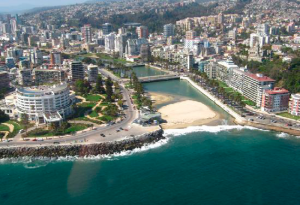By Jose Guzman
Introduction
In 2003, UNESCO declared the historic quarter of Valparaiso, Chile a World Heritage Site. While policies were developed to preserve the patrimony of the city, political and economic interests have aligned to attract investments and tourism, which has resulted in social transformations and building projects that provides rents and benefits to a few while excluding many of the city’s residents. To address these equity concerns stemming from the historic preservation efforts, the community-based organization Ciudadanos Por Valparaiso (Citizens for Valparaiso) works with community groups, other city and regional organizations, and institutions such as universities, the municipality, and research centers to provide information about Valparaiso’s patrimonial value (Rojas Muñoz, 2013). One of the projects developed by Ciudadanos Por Valparaiso is the Lugar Valioso (Valuable place), a guide that includes traditional commercial establishments and other institutions that represent the identity and diversity of the city. Another accomplishment was the Que Nadie Nos Tape La Vista (That nobody blocks our sight) campaign, which helped modify the city’s regulatory code to guarantee the right of citizens to have a clear view of the natural amphitheater.

Analysis
At face value, UNESCO aims to protect heritage sites; i.e. the cultural and natural legacies that humanity leaves for future generations to enjoy and be inspired by. In the case of Valparaiso’s historic quarter, the legacy meant to be preserved is the image of the city as a center of early globalization, as it became one of the leading commercial ports on the Pacific coast of South America in the 19th century. UNESCO’s criteria for selecting Valparaiso include the city’s amphitheater layout, due to the narrow coastal plains and steep hills; the particular architecture developed at the time to adapt to geographical conditions; and a diverse population of inhabitants who came from different parts of the world. y being designated a heritage site, Valparaiso’s historic quarter was deemed universal as belonging “to all the people in the world, irrespective of the territory on which they are located”(UNESCO World Heritage Center). Valparaiso thus becomes an emblem of a global city of the past.
However, the dominant conception of a heritage site as assigned by UNESCO cannot be separated from the reality of Valparaiso. According to Bailey (2013), the image of Valparaiso as a patrimony city is tied to undemocratic forms of development. In the first place, municipal and local government debt has increased as a result of the work to maintain the heritage site according to UNESCO standards. Second, the heritage policies have primarily benefited the tourism and hotel industries at the expense of local entrepreneurs and other citizens, leading to large-scale urban economic developments exemplified by shopping malls and large real estate developments. These developments have modified the urban landscape in stark contrast with the urban design vision as originally formulated when Valparaiso as a world heritage site was conceived (Bailey Bergamin, 2013).
Implication
The criteria that UNESCO places on cities to be included in the list of world heritage sites can be scrutinized through the critical lens of discourse analysis, which emphasizes the power of discourses in shaping the ways in “which reality is imagined and acted upon” (Escobar 2001, p. 5). For example, in the case of Rio de Janeiro, Gaffney uses discourse analysis to examine the dominant narratives that politicians, corporations, international sports organizations, marketing firms, and the media use to promote the production and consumption of sport mega events. These narratives include those of globalization, transformation of a better society through sport, brand recognition of the city, and the legacy the city can achieve by becoming a host to the 2016 Olympics. The case of Valparaiso is a similar example of the power of dominant narratives in shaping planning policies. Through its designation, UNESCO claims the city as the place of origin of globalization in the 19th century. There is also a branding element to this designation, as the economic value of the site increases once it achieves the prestigious status of a world heritage site (Gaffney, 2015). Valparaiso’s urban development following its gain of status as a world heritage site resonates with other attempts to gain significance as “global” cities, “where visions are often conceived outside the urban policy sphere by private developers and politically powerful elites” (Paling, 2012, p. 2904)
In this context, organizations like Ciudadanos Por Valparaiso try to produce a more nuanced and representative concept of city as patrimony. The “lugar valioso” project, for example, aims to promote “authentic” conceptions of patrimonial artifacts and structures and to prioritize local businessmen and enterprises. Instead of reproducing standard models of development, the organization pursues planning based in local realities. By facilitating citizen petitions and securing national and international support for the Que Nadie Nos Tape La Vista campaigm, Ciudadanos Por Valparaiso succeeded in reforming building codes based in the understanding of the city as a natural amphitheater. Thus the work of Ciudadanos Por Valparaiso reflect Mendoza’s concept of “protesting with proposals”, whereby loose networks of planning actors strategically take advantage of the fissures of neoliberal governance to present alternative planning solutions from the base (Sletto et al., 2014). In the case of Ciudadanos Por Valparaiso, citizen groups align with different stakeholders to contest the planning model promoted by political and economic interests, in the process providing alternative conceptions of patrimony and fostering more democratic urban planning and management.
